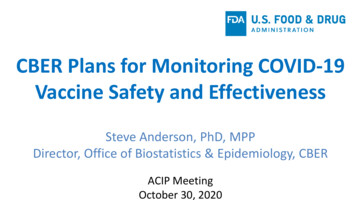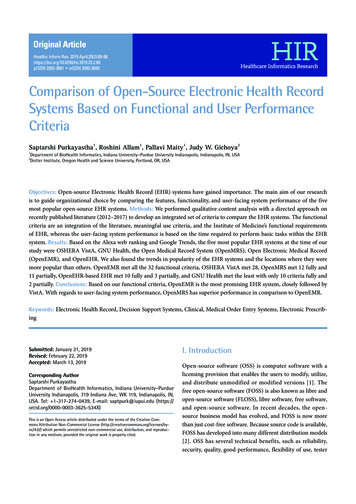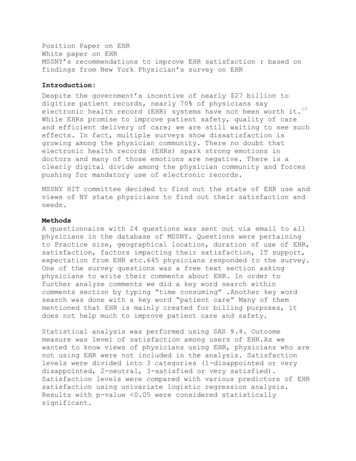Transcription
Using EHRs for Care Management andTracking9/4/2015September 10, 2015Using the EHR for CareManagement and TrackingJean Harpel, MSN, RN, GCNS-BC, CPASRMLorraine Possanza, DPM, JD, MBEPaul Anderson 2015 EC RI I N S TI TU TELearning Objectives 2Learn why it is important to have good trackingmechanisms in placeRecognize the tracking tools currently availableIdentify key areas to trackIdentify the ways to measure the effectiveness of tracking 2015 EC RI I N S TI TU TE1
Using EHRs for Care Management andTracking9/4/2015Why Is It Important to Create, Monitor, andMaintain Tracking Mechanisms? 2015 EC RI I N S TI TU TE3Reasons for Tracking Mechanisms 4Improve patient care and patient rapportReduce missed or delayed diagnosesIncrease patient communicationMaximize electronic health record (EHR) technologyAchieve external recognition (patient centered medicalhome [PCMH])Mitigate malpractice risk 2015 EC RI I N S TI TU TE2
Using EHRs for Care Management andTracking9/4/2015Communication with Ms. Key Mammogram results not communicated to Ms. KeyDr. Derm’s office did not communicate results of biopsyto Dr. Smith; possibly delays treatment for Ms. KeyDetermine why Ms. Key did not follow up withdermatologist 2015 EC RI I N S TI TU TE5Challenges to Tracking 6Large number of patients with complex medical conditionsFragmentation of healthcare deliveryCo-management of complex conditionsVolume of referrals/tests/hospitalizationsCumbersome and time consumingLimited staff 2015 EC RI I N S TI TU TE3
Using EHRs for Care Management andTracking9/4/2015What Areas Are Important to Track? 2015 EC RI I N S TI TU TE7Key Areas to Track Include Referrals and consults Hospital admissions ED visits Diagnostic testing8 2015 EC RI I N S TI TU TE4
Using EHRs for Care Management andTracking9/4/2015Other Areas for Tracking Medically-complex patientsMissed appointmentsPrescription compliancePatient engagementPreventative careVaccinations 2015 EC RI I N S TI TU TE9What Is Needed for Tracking?10 2015 EC RI I N S TI TU TE5
Using EHRs for Care Management andTracking9/4/2015Tools for Tracking LogsEHRsPolicies and proceduresStaff educationOpen communication 2015 EC RI I N S TI TU TE11Tracking Policy 12Ensure that tracking policy is currentConfirm policy is fully implemented by staffEducate new staff on policyCommunicate policy updates or revisions to all staff, 2015 EC RI I N S TI TU TE6
Using EHRs for Care Management andTracking9/4/2015What Is Important in Managing ReferralTracking? 2015 EC RI I N S TI TU TE13Important Aspects of Managing Referrals 14Monitor availability andaccess to specialistappointmentsKnow what specialistssee patients withparticular insurance Educate the providers onhow to manage (anddocument) non-compliantpatients 2015 EC RI I N S TI TU TE7
Using EHRs for Care Management andTracking9/4/2015Referral Tracking Educate providers on tracking referralsCreate a centralized communication systemFollow up with patients after 30-60 days from the date thereferral was madeNotify the provider who made the referral if the patient haschosen NOT to follow through with the referral 2015 EC RI I N S TI TU TE15Referral Tracking 16Use interfacing electronic records to allow easy referral andorder form completionCreate a “check out” procedure for patients to getassistance with scheduling referral before they leave theofficePrint out information sheets with telephone number andaddress of referral office 2015 EC RI I N S TI TU TE8
Using EHRs for Care Management andTracking9/4/2015What Items Should Be Included in TrackingPolicies?17 2015 EC RI I N S TI TU TEElements for a Referral Tracking Policy Every referral goes into a tracking log (paper or electronic) Specify targets for each type of referral (urgent, routine, andpatient requested) Identify contingency plans (what if’s) Pinpoint referral follow-up and who is accountable Address patient non-compliance in referrals Document appropriately18 2015 EC RI I N S TI TU TE9
Using EHRs for Care Management andTracking9/4/2015Elements of a Hospitalization Tracking Policy Establish a tracking andmonitoring system forreceiving hospital admissioninformationCollect patient information,date of visit or admission,date of notification, reasonfor visit, documentationreceived, and documentationrequestedIdentify who is responsiblefor receiving admissioninformation Implement a mechanismfor follow up with thepatient, provider, oroutside facility to requestpertinent information 2015 EC RI I N S TI TU TE19Elements of an ED/Urgent Care TrackingPolicy 20Educate patients about providing contacts for theirprimary care provider to ED and Urgent Care centersCentralize responsibility for monitoring and following upwith outside facilitiesCoordinate care recommendations and follow-up withpatientsDocument appropriately 2015 EC RI I N S TI TU TE10
Using EHRs for Care Management andTracking9/4/2015Elements to Include in Diagnostic TestTracking 21Track all ordered testsAssign specific staff members tomonitor the test tracking logsInclude fail-safe contingency plans(what if’s)Ensure that the need for follow-up isstressed and who is accountablePeriodically audit results to be surethat the providers have reviewedand initialed them 2015 EC RI I N S TI TU TEAdditional Considerations in Test Tracking 22Communicate every test (including normal results) topatientsSpecify time frame targets for communicating each type ofresult (critical, abnormal and normal)Document patient notification in the chartDocument patient decisions not to undergo recommendedtests and that patients have been informed of the risks 2015 EC RI I N S TI TU TE11
Using EHRs for Care Management andTracking9/4/2015Why Is Tracking Beneficial? 2015 EC RI I N S TI TU TE23Benefits of Tracking and Using EHRs forTracking 24Improved health outcomesContinual quality improvementIncreased patient satisfactionReduced liabilityAutomated work processesMechanism to track 2015 EC RI I N S TI TU TE12
Using EHRs for Care Management andTracking9/4/2015Benefits of Tracking Achieved byMeasurementCompleted referrals X 100 Obtain the % of referralsTotal referrals made Identify the status of the referral (cancelled, complete, noshow, no appointment made)Track monthly, quarterly, or at some specific time intervalMonitor over timeNote improvements or areas that require additional focus 2015 EC RI I N S TI TU TE25Measuring and Monitoring 26Determine number of referrals by provider during a giventimeframeIdentify the referrals that require follow-up (helps identifycare coordination issues)Centralize responsibility and identify staff to conductfollow-upMake appointments in coordination with patientsProvide appropriate records to consultants whichimproves communication 2015 EC RI I N S TI TU TE13
Using EHRs for Care Management andTracking9/4/2015Would Ms. Key’s Care Have Improved WithAdditional Tracking? 27Barriers to clinical careMedically complex patientsMissed appointments 2015 EC RI I N S TI TU TEDid the Health Center Recognize Ms. Keyas a High-Risk Patient?28 2015 EC RI I N S TI TU TE14
Using EHRs for Care Management andTracking9/4/2015Characteristics of the High-Risk Patient Number of issuesIdentified chronic conditions (e.g., diabetes, heart failure,cancer)Acute conditions that require monitoringSocial or behavioral issues that complicate care Transportation issues Erratic work schedules Language difficulties and/orcultural considerations 2015 EC RI I N S TI TU TE29Measurement 30Process for recognizing high-risk patients Electronic systems Measurement: determine how many high-risk patientsare in your practice 2015 EC RI I N S TI TU TE15
Using EHRs for Care Management andTracking9/4/2015How Can You Accommodate High-RiskPatients? 2015 EC RI I N S TI TU TE31Should You Consider 32Are patient discharge summary sheets available inmultiple languages?Were patient education materials printed out in hostlanguage and at appropriate reading level?Are translation services available?Are you referring patients to offices that can alsoaccommodate these patients? 2015 EC RI I N S TI TU TE16
Using EHRs for Care Management andTracking9/4/2015Are You Effectively Using Feedback Loops? 2015 EC RI I N S TI TU TE33Examples of Areas Where Feedback LoopsAre Beneficial 34EHRs facilitate feedback loops (e.g., sent 2 prescriptionswere they received by the pharmacy?)Outside consultants (e.g., request for biopsy results sentto dermatology office) 2015 EC RI I N S TI TU TE17
Using EHRs for Care Management andTracking9/4/2015What Are Some Other Advantages of Usingthe EHR? 2015 EC RI I N S TI TU TE35EHRs Can Make Information Available 36Reduce medical errorsDecrease the number of repeated or unnecessary testsImprove information flowAllow providers to have information about otherconditions that they may not be directly treatingCreate alerts in the EHR for preventative care 2015 EC RI I N S TI TU TE18
Using EHRs for Care Management andTracking9/4/2015Avoid Medication Errors According to ONC, the 2013 National Ambulatory MedicalCare Physician Workflow Survey found that three timesthe number of physicians reported that their EHRs helpedthem avoid a medication errorAlmost 70% said that lab and medication reminders oralerts aided them in preventing potential patient harm45% reported a specific EHR feature that had alertedthem to a possible medication errorEHRs also helped twice as many physicians choose thecorrect lab test 2015 EC RI I N S TI TU TE37Additional Benefits 38Use e-prescriptions to decrease errors from handwritingCheck for drug-drug/drug-allergy interactionsProvide alerts and remindersDecrease wait time for medications sent electronically tothe pharmacyUse clinical decision support (protocols, best practices,condition-specific orders and tests) 2015 EC RI I N S TI TU TE19
Using EHRs for Care Management andTracking9/4/2015Summary EHRs are becoming prominent tools for trackingClinical tracking Improves care quality Decreases duplication Aids in communication Increases patient satisfactionKey areas to track are referrals, hospitalizations, ED visits,referrals, and consults, along with other areas specific toyour facilityMeasuring evaluates effectiveness and improvement39 2015 EC RI I N S TI TU TEClinical Risk Management Resources Test Tracking and Follow-Up Toolkit Special Report: Test Tracking and Follow-Up Hospital Admission and Emergency Visit Log Sample Policy Guide: Tracking Hospital and EmergencyRoom Visits Tracking Hospitalizations: Patient Card and Procedures Archived Webinar: Getting on the Right Track: Tracking TestResults, No-Show Appointments, and Hospital Visits Archived Webinar: Building and Maintaining an EffectiveTriage System40 2015 EC RI I N S TI TU TE20
Using EHRs for Care Management andTracking9/4/2015References HRSA FTCA Tip Sheet: http://bphc.hrsa.gov/ftcatipsheet.pdf Macri, J, Improving Referral Tracking Processes at aCommunity Health Center in Southern Alabama, database/MacriJuliana-Paper.pdf Strauss, Chen, Yee, et al., Implementation of an ElectronicReferral System for Outpatient Specialty Care, AMIA AnnualSymposium Proceedings, 22 October 2011, /PMC3243286/ 2015 EC RI I N S TI TU TE41References AHRQ, Improving Your Office Testing Process, Toolkit forRapid-Cycle Patient Safety and Quality estingtoolkit/index.html AHRQ, Using Health IT in Practice Redesign: Impact ofHealth IT on Workflow, Examining the Relationship BetweenHealth IT and Ambulatory Care Workflow d-redesign-in-tn-finalreport.pdf42 2015 EC RI I N S TI TU TE21
Using EHRs for Care Management andTracking9/4/2015References AHRQ, Using Health Information Technology to SupportQuality Improvement in Primary upport%20QI.pdf 2015 EC RI I N S TI TU TE43Clinical RM Program@ecri.org(610) 825-6000, x5200 2015 EC RI I N S TI TU TE22
Using EHRs for Care Management and Tracking 9/4/2015 8 15 2015 ECRI INSTITUTE Referral Tracking Educate providers on tracking referrals Create a centralized communication system Follow up with patients after 30-60 days from the date the referral was made Notify the provider who made the referral if the patient has chosen NOT to follow through with the referral











